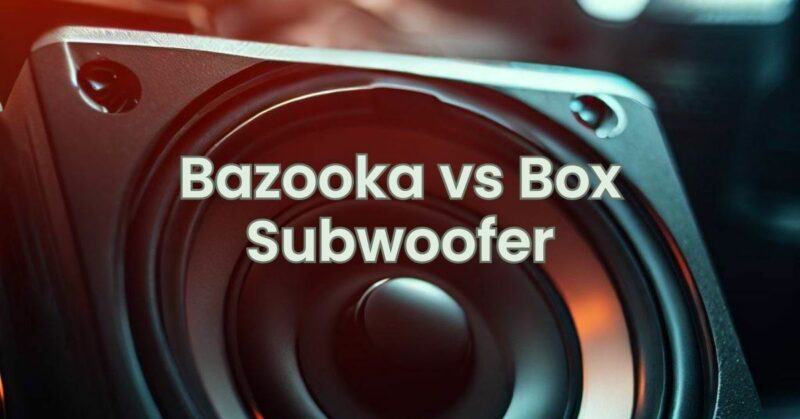When it comes to adding bass to your audio system, there are various options available, each with its own characteristics and design philosophies. Two popular choices are the Bazooka subwoofer and the box subwoofer. In this article, we will compare these two approaches to low-end audio and discuss their respective advantages and considerations to help you make an informed decision when choosing a subwoofer for your audio setup.
Bazooka Subwoofer:
The Bazooka subwoofer is a unique type of subwoofer that takes the shape of a cylindrical tube. It is known for its compact design and versatility. Bazooka subwoofers are typically passive, meaning they require an external amplifier to power them. They are available in different sizes and configurations, ranging from single to dual voice coil models.
Box Subwoofer:
The box subwoofer, also known as an enclosure subwoofer, is a more traditional approach to low-frequency reproduction. It consists of a subwoofer driver mounted inside a specialized enclosure, commonly made of wood or fiberglass. The enclosure is carefully designed to optimize the performance of the subwoofer driver and enhance bass response. Box subwoofers are available in various sizes and designs, including sealed, ported, and bandpass enclosures.
Sound Characteristics:
- Bass Response: Both Bazooka and box subwoofers can deliver powerful bass, but their sound characteristics may differ. Bazooka subwoofers tend to provide a more boomy and punchy bass with a focus on mid-bass frequencies. On the other hand, box subwoofers can offer a tighter and more controlled bass response, with better low-frequency extension and the ability to reproduce sub-bass frequencies more effectively.
- Directionality: Bazooka subwoofers are designed to radiate sound in all directions, providing an omnidirectional bass experience. This can be advantageous in certain applications, such as car audio systems, where the subwoofer can be positioned more flexibly. Box subwoofers, on the other hand, typically radiate sound from the front or through a port, which can offer more directional control and precision in bass reproduction.
Considerations:
- Space and Installation: Bazooka subwoofers are often preferred for their space-saving design. Their cylindrical shape allows for easy installation in tight spaces, such as trunks or behind seats in vehicles. Box subwoofers, on the other hand, require more room due to the enclosure size and may require additional consideration for installation, such as ensuring proper air space and mounting options.
- Amplification: Bazooka subwoofers are usually passive, meaning they require an external amplifier for power. This provides flexibility in choosing an amplifier with the desired specifications and power output. Box subwoofers may be available in both passive and powered versions, with the latter incorporating an amplifier within the enclosure for a more integrated solution.
- Customization: Box subwoofers offer more customization options, as different enclosure designs (sealed, ported, or bandpass) can significantly impact the bass response. This allows you to tailor the subwoofer’s performance to your specific preferences and audio environment. Bazooka subwoofers, while versatile, have a more standardized design and may offer less customization in terms of enclosure characteristics.
Choosing between a Bazooka subwoofer and a box subwoofer ultimately depends on your specific requirements and preferences. Bazooka subwoofers offer a compact and versatile design, with an emphasis on mid-bass frequencies and omnidirectional sound dispersion. Box subwoofers, on the other hand, provide a more controlled and customizable bass response, with various enclosure options to suit different audio environments. Consider factors such as space availability, desired sound characteristics, installation ease, and amplification requirements when making your decision. By understanding the unique attributes of each subwoofer type, you can make an informed choice that aligns with your audio goals and enhances your listening experience.


